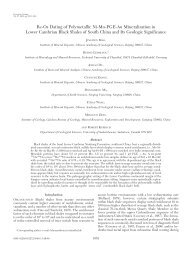MACROCRYSTALS OF Pt–Fe ALLOY FROM THE ... - RRuff
MACROCRYSTALS OF Pt–Fe ALLOY FROM THE ... - RRuff
MACROCRYSTALS OF Pt–Fe ALLOY FROM THE ... - RRuff
Create successful ePaper yourself
Turn your PDF publications into a flip-book with our unique Google optimized e-Paper software.
602 <strong>THE</strong> CANADIAN MINERALOGIST<br />
dans les placers éluvionnaires et alluvionnaires développés dans le massif de Kondyor, intrusion zonée à clinopyroxénite et<br />
dunite, d’âge paléozoïque ou mésozoïque. Selon l’assemblage d’inclusions, les macrocristaux d’alliage <strong>Pt–Fe</strong> sont associés avec<br />
des venues tardives de clinopyroxénite à apatite – magnétite – phlogopite, et se seraient formés dans un milieu tardimagmatique<br />
pegmatitique. Ces gros cristaux ont subi les effets d’une recristallisation hydrothermale en présence d’une saumure porteuse d’or,<br />
argent, palladium et cuivre, ce qui a produit une grande variété de composés intermétalliques, y inclus des phases intermétalliques<br />
porteuses de Pd. Les solutions aqueuses portaient aussi en quantités moindres bismuth, étain, antomoine et tellurium.<br />
(Traduit par la Rédaction)<br />
Mots-clés: platine ferreux, taimyrite, tatyanaïte, atokite, rustenburgite, sobolevskite, monchéite–insizwaïte, tétra-auricupride,<br />
pluton de type Alaska, Kondyor, bouclier d’Aldan, Russie.<br />
INTRODUCTION<br />
The Kondyor PGE placer deposit currently has a<br />
production of about 5 t PGE/year, second in Russia to<br />
the Noril’sk Ni–PGE district, with about 100 t PGE/<br />
year. The main PGM in the Kondyor deposit is <strong>Pt–Fe</strong><br />
alloy of xenomorphic shape and of primitive cubic cell<br />
type (Nekrasov et al. 1994), which in the classification<br />
scheme of Cabri & Feather (1975) is isoferroplatinum.<br />
However, the Kondyor placer is also known for spectacular<br />
euhedral <strong>Pt–Fe</strong> alloy crystals, which can reach<br />
up to several cm across (Sushkin 1995, Cabri &<br />
Laflamme 1997). These coarse crystals have a face-centered<br />
cubic cell and consist of ferroan platinum<br />
(Nekrasov et al. 1994, Cabri & Laflamme 1997). In the<br />
following, we will use the general term of <strong>Pt–Fe</strong> alloy<br />
for both variants.<br />
Coarse-grained <strong>Pt–Fe</strong> alloy crystals are known only<br />
from the Kondyor deposit, and have attracted much attention<br />
from mineral collectors (Fehr et al. 1995,<br />
Gebhard & Schlüter 1996, Weiss et al. 2002) and scientists<br />
alike (Mochalov 1994, Sushkin 1995, Nekrasov et<br />
al. 1994, 1997, 1999, Cabri & Laflamme 1997).<br />
An intriguing feature of the macrocrystals of <strong>Pt–Fe</strong><br />
alloy, i.e., crystals whose diameter exceeds 1.0 mm, in<br />
line with the definition of macrocrystalline rock textures:<br />
Jackson (1997, p. 382), is their unusually low<br />
content of the minor PGE elements (Nekrasov et al.<br />
1994). An ion-microprobe reconnaissance study by<br />
Cabri et al. (1998) revealed Re and Os concentrations<br />
below the limits of detection in one large crystal (










